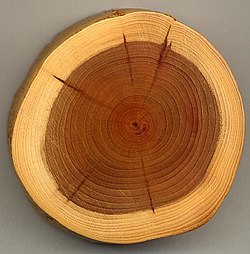Pith
This article needs additional citations for verification. (December 2014) |


Pith, or medulla, is a
While new pith growth is usually white or pale in color, as the tissue ages it commonly darkens to a deeper brown color. In
The term pith is also used to refer to the pale, spongy inner layer of the rind, more properly called
Uses
Food
The pith of the sago palm, although highly toxic to animals in its raw form, is an important human food source in Melanesia and Micronesia by virtue of its starch content and its availability. There is a simple process of starch extraction from sago pith that leaches away a sufficient amount of the toxins and thus only the starch component is consumed. Current processes for starch extraction are generally only about 50% efficient, however, with the other half remaining in residual pith waste.[3] The form of the starch after processing is similar to tapioca.
Other foods sometimes mistakenly called piths include heart of palm (actually the core of the bud) and banana piths (actually the rolled up young leaves).

Pith helmets
The spongy wood of the pith wood plant or other similar species, often mistakenly called pith, was once used to make pith helmets.[4][5]
Watch cleaning
Pith wood is a
Light
Dried pith (which is actually the center of the leaf) of certain rush plants soaked in fat or grease, held using a rushlight, was used as home lighting. Beginning in the 17th century, it would continue to be used in this method until the mid-20th century. It saw a brief revival during World War 2.
References
- ISBN 978-0-135-18874-3.
- ^ "Pith". Dictionary.com Unabridged. Random House, Inc. Retrieved January 20, 2011.
- ISBN 978-981-10-5268-2.
- ^ AskOxford.com - Pith helmet
- ISBN 92-5-105064-3.
- ^ a b Britten, Frederick James (1896), The Watch & Clock Makers' Handbook, Dictionary and Guide, Spon, p. 144
- ISBN 9781473339408
